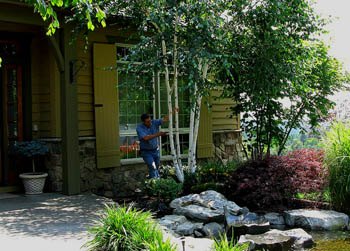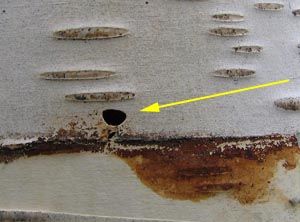
Bronze Birch Borer
by M. D. Vaden: 2008 - 2020
Between 1988 and about 1996, bronze birch borer symptoms or damage in our area seemed insignificant. Then in the mid-1990s, the problem seemed to increase noticeably.

The problem was more common by 2006, and by 2008, I spotted about one birch per week with symptoms or damage. Even though birch are a favorite, I was hesitant to plant Himalayan birch at our own home - having planted 3 purple beech instead. For designs, I probably won't add more than one Betula jaquemontii per yard anymore: maybe up to three.
In the image to the right, I'm pruning a Himalayan white birch, with no birch borers. This is just to show what that plant and trunk looks like.
Bronze birch borer is the larvae stage of an adult beetle with a shiny copper metallic appearance. Adults are about 3/8” or 10mm long and rarely noticed. The larvae that do the damage have no legs. They are white, segmented grub-like creatures with an enlarged area behind the head - hence the nickname “flathead borers”. The larvae live beneath the birch bark.
This insect is a frequent cause of damage to birch, primarily those which are stressed. This problem can be reduced by proper plant care, site selection and control of the insect.

advertisement
Here are a few types of birch species that you may have, or consider planting. To the right of each name, is a comment about how susceptible each of those species is to bronze birch borer:
- Himalayan birch - Betula Jaquemontii - highly susceptible
- White European birch - Betula pendula - highly susceptible
- Yellow Birch - Betula alleghaniensis - moderately susceptible
- Paper, White, Canoe Birch - Betula papyrifera - moderately susceptible
- River, Red Birch - Betula nigra - minimally susceptible
- Heritage Birch - Betula nigra ‘Heritage' - minimally susceptible
In one way, these borers are irritating. On the other hand, the genetic ability stored in these insects is remarkable, from adult to adult. Generation after generation, they survive, reproduce, feed, emerge and live like clockwork. They seem to be at the right place, doing their job in nature; and they don't need a formal education to do it.

The photo to the left shows the holes left by this birch borer. As larvae mature and emerge, they leave small “D” shaped exit holes in the birch bark, clearly visible. It's sort of a sideways D, or, maybe a bit like an icon of the top of a chef's hat.
In this image, the horizontal slits are normal markings on the birch trunk, and nothing to be concerned about.
The borer insect larvae feed in the phloem (food transport) tissue of the trunk and larger branches - just beneath the bark. This feeding girdles or interupts the phloem, reducing the volume of photosynthesized food transported from the leaves to the roots. Eventually, root starvation reduces root growth and function. Then the birch begins to die back, sometimes starting in the upper crown. The roots become unable to effectively transfer water from the soil to the rest of the plant.
These borers overwinter in feeding galleries as a mature larvae, pupating at early spring. Adult beetles start to emerge May to June. This lasts into July. Adults feed on leaves and mate soon after emergence. Next, females lay eggs in bark cracks, crevices and protected locations - they may chew tiny cavities in bark. In about one week, small larvae emerge and chew through the bark into phloem tissue. These make zigzag patterns in the phloem as they feed, permanently damaging phloem tissue. These live and remain through winter, and in spring the cycle repeats itself.
Know how to care for your birch
1. Select the right location for planting. A good location is where the soil remains cooler, but the sun is able to shine on the leaves most of the day. East and north sides buildings are good. Or, prepare a design plan that shades the soil of the root zone with small plants or shrubs.
2. Pick a species that is not very susceptible.
3. Maintain 2 to 4 inches of mulch. This helps to keep soil cool and moist.
4. Maintain good plant care. Water sufficiently - primarily through drought periods..
5. Try to avoid pruning these from May through July. This is the adult insect flight period and one researcher's study indicated that female adults can be attracted to fresh pruning cuts. Leave enough foliage to keep the soil shaded. Pro standards are to remove 25% or less of the canopy foliage.
6. Fertilizer has no real benefit to control infestation. Only fertilize if signs of nutrient deficiency are apparent - such as chlorosis. Feel free to get a soil test too. Never hurts to know what your ground has for nutrient levels.
There may be some practical chemical control. You can discuss this with a professional care provider. I think that the best approach to reducing losses, is to limit birch tree planting to 3 trees, or plant resistant species. And pay attention to care.